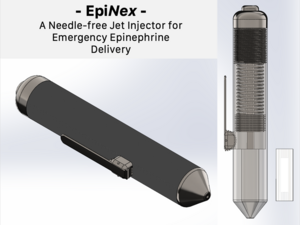
For several years, epinephrine has been the primary treatment to address severe allergic reactions through needle-based autoinjectors such as the EpiPen, Auvi-Q, and Symjepi. However, there have been serious complications associated with these types of injections in previous years. For instance, these autoinjectors have been recalled by the FDA due to reported complications, such as accidental exposure, device failure, drug ineffectiveness, and lacerations due to embedded and hooked needles. Altogether, these complications can cause a delay in epinephrine administration and put an individual at serious risk. Additionally, needle-phobia can severely hinder effective injections. Finally, EpiPen and similar devices have seen dramatic price increases, making proper prevention and treatment out of reach for some individuals.
To address these issues, a needle-free, cartridge-based, epinephrine jet injector for the emergency treatment of anaphylaxis, is proposed. EpiNex utilizes spring power to eject epinephrine solution out of a small nozzle at high velocity. This ejection stream is capable of penetrating the skin without causing excessive damage to the tissue, effectively performing an epinephrine injection without the use of a traditional needle. Additionally, the product will be designed with reusability in mind. The needleless injector will employ a reloadable cartridge system and a levered cocking mechanism to eliminate waste and reduce costs associated with current single-use devices.
| Attachment | Size |
|---|---|
| 863.22 KB | |
| 2.68 MB | |
| 1.45 MB |

